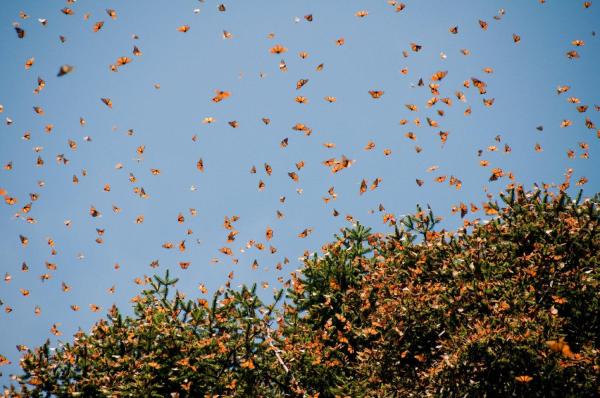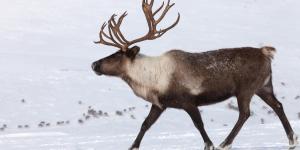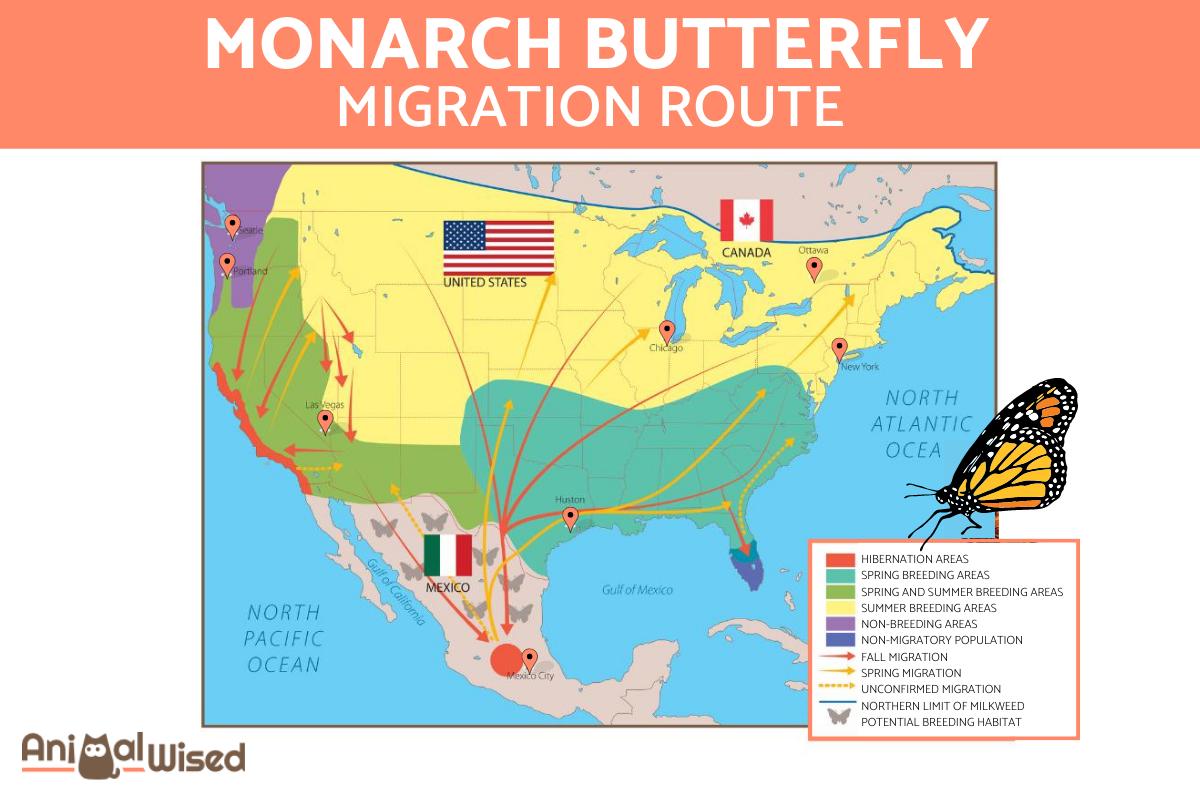Where Do Monarch Butterflies Migrate?


The monarch butterfly is a fascinating insect that is famous for its remarkable migration. Every year, millions of monarchs make an incredible journey that can take them thousands of miles, from their breeding grounds in North America to their wintering grounds in Mexico. The migration of monarch butterflies is a long and remarkable journey that can last several months and cover thousands of miles. It is a testament to the incredible endurance and adaptability of these fascinating insects.
The following AnimalWised article explains everything you need to know about the migration of monarch butterflies.
What are monarch butterflies?
The monarch butterfly is one of the best known and studied butterflies on our planet. They are known for their distinctive orange and black wings. They are found primarily in North America, from southern Canada to Mexico. Monarch butterflies belong to the Nymphalidae family, which includes over 6,000 species of butterflies and moths.
The vivid coloration of the monarch butterfly serves as a warning to predators that they are not a suitable meal. This is because their distinct coloration is an indication of the toxins they contain. As a result of consuming milkweed, monarch butterflies accumulate toxins in their bodies, making them inedible to potential predators.
Monarch butterflies are important pollinators and are known for their long-distance migration that spans several generations.
The monarch butterfly is also threatened by habitat loss, pesticides, and climate change, and its populations have declined in recent years.
You may also be interested in the main differences between moths and butterflies.
When do monarch butterflies migrate?
Monarch butterflies migrate twice a year, once in the fall and once in the spring. The fall migration usually begins in August or September and lasts until November, while the spring migration occurs from March to May.
During the fall migration, monarch butterflies in the northern part of their range (Canada and the United States) begin flying south toward their wintering grounds in Mexico.
In spring, monarch butterflies begin their journey back north to their breeding grounds. Along the way, they mate and lay eggs, and the next generation continues the migration. Spring migration is not as well known as fall migration, but it is still an important part of the monarch butterfly's life cycle.
Do not miss this other article where we explain the different body parts of a butterfly.
Why do monarch butterflies migrate?
Monarch butterflies migrate for a variety of reasons, including escaping cold temperatures and finding food and suitable breeding sites. The migration cycle of the monarch butterfly is determined by a combination of ecological and biological factors.
As mentioned before, monarch butterflies migrate from their breeding grounds in the northern part of North America to overwintering grounds in the mountains of central Mexico. They do this to escape the cold temperatures and lack of food that are common during the winter months in the north.
In the spring, monarch butterflies begin their journey back north to their breeding grounds. They do this to find suitable breeding sites and food sources. As they travel north, they mate and lay their eggs on milkweed plants, which are the only food source for the monarch's caterpillars.
Do not miss this other article where we explain how butterflies are born.
How long is the monarch butterfly migration?
The duration of the migration of monarch butterflies depends on the distance traveled and the route.
The longest and best known migration is that of monarchs in eastern North America, covering a distance of up to 3,000 miles (4,800 km). The fall migration from northern breeding grounds to wintering grounds in central Mexico takes several months. Monarchs travel up to 50 miles (80 km) per day, stopping along the way to rest and feed. They may also be delayed by adverse weather conditions, such as high winds or cold temperatures.
Monarchs overwinter for several months in Mexico, where they congregate in large groups to conserve energy and stay warm. In spring, they begin their journey back north, mating and laying eggs along the way. The spring migration also lasts several months as the monarchs are on their way to their breeding grounds in the north.
However, it is important to note that the duration of monarch butterfly migration depends on various factors, including the location of their breeding grounds, the availability of food and water, and weather conditions. In general, monarch migration can last numerous weeks or even months.
Do not miss this other article where we explain how butterflies reproduce?

Where do monarch butterflies migrate?
Monarch butterfly migration routes vary by region and population. The North American population of the monarch butterfly is best known for its long-distance migration, which occurs in three stages:
Breeding
During the summer months, monarchs breed in the northern parts of the United States and Canada, laying their eggs on milkweed plants.
Fall migration
When temperatures cool in the fall, adult butterflies begin their migration south toward Mexico. Monarchs from the eastern population of North America usually fly toward the mountains of central Mexico, while monarchs from the western population migrate toward the coast of California. Along the way, the butterflies stop to feed on flower nectar and replenish their energy reserves.
Hibernation
Monarchs arrive at their wintering grounds in Mexico in late fall and early winter. They congregate in large numbers on oyamel fir trees in the high-elevation forests of central Mexico, where they remain until spring. As soon as it gets warmer, the butterflies make their way back north to their breeding grounds, where they mate and lay eggs.
Spring migration
In the spring, the monarchs begin their return journey northward. The females lay eggs along the way, and the new generation of monarchs continues the journey north.
Summer breeding
The new generation of monarchs reaches their summer breeding grounds in the U.S. and Canada, and the cycle begins again.
In other regions, monarch butterflies have their own unique migration patterns. In Australia, for example, monarch butterflies migrate from the tropics to southern parts of the country during the winter months. In the South Pacific, monarchs migrate from the Cook Islands to New Zealand.
Do not miss this other article where we go into more detail about the life cycle of a butterfly.

What factors threaten the migration of the monarch butterfly?
In the IUCN's first report of 2022, the monarch butterfly was classified as a species that was not of immediate conservation concern. However, in July of the same year, the organization issued a communication that announced the reclassification of the migratory subspecies (D. p. plexippus) as endangered.
There are several factors that threaten the migration phenomenon of the monarch butterfly, including:
- Habitat loss: monarchs rely on milkweeds as their primary food source, and the loss of milkweeds due to development, agriculture, and herbicide use has significantly reduced their breeding habitat.
- Climate Change: changes in weather and temperatures can affect the timing and success of monarch migration, as well as the availability of food and water on their journey.
- Pesticide use: pesticides and herbicides can kill monarchs directly or indirectly by reducing the availability of their food source.
- Illegal logging: the forests in Mexico where monarchs winter are threatened by illegal logging that can destroy their wintering grounds.
- Urbanization: urban development can disrupt monarch migration patterns by destroying their breeding and foraging habitats and bringing pollution and other stressors.
- Lack of awareness: many people are unaware of the importance of monarchs and their migrations, which can lead to a lack of conservation efforts and funding.
All of these factors contribute to the decline of the monarch butterfly population and threaten its spectacular migratory phenomenon. To ensure the survival of this remarkable species, it is important to address these threats through conservation efforts such as habitat restoration, pesticide reduction, and education.
You may be interested in this other article where we talk about the 10 endangered animals of the world.

If you want to read similar articles to Where Do Monarch Butterflies Migrate?, we recommend you visit our Facts about the animal kingdom category.
- CONABIO (2023). The great journey Available at: https://biodiversidad.gob.mx/especies/espPrioritaria/monarca/travesia
- Reppert, SM (2018). Demystifying Monarch Butterfly Migration . Current Biology. 28 (17): R1009–1022. Available at: https://pubmed.ncbi.nlm.nih.gov/30205052/
- IUCN (2022). The migratory monarch butterfly is now Endangered - IUCN Red List . Available at: https://www.iucn.org/es/comunicado-de-prensa/202207/la-mariposa-monarca-migratoria-es-ahora-en-peligro-lista-roja-de-la
- Walker, A.; Oberhauser, KS: Pelton, EM; Pleasants, J.M. (2022). Danaus plexippus (errata version published in 2022) . The IUCN Red List of Threatened Species 2022. Available at: https://dx.doi.org/10.2305/IUCN.UK.2022-1.RLTS.T159971A219149911.en








